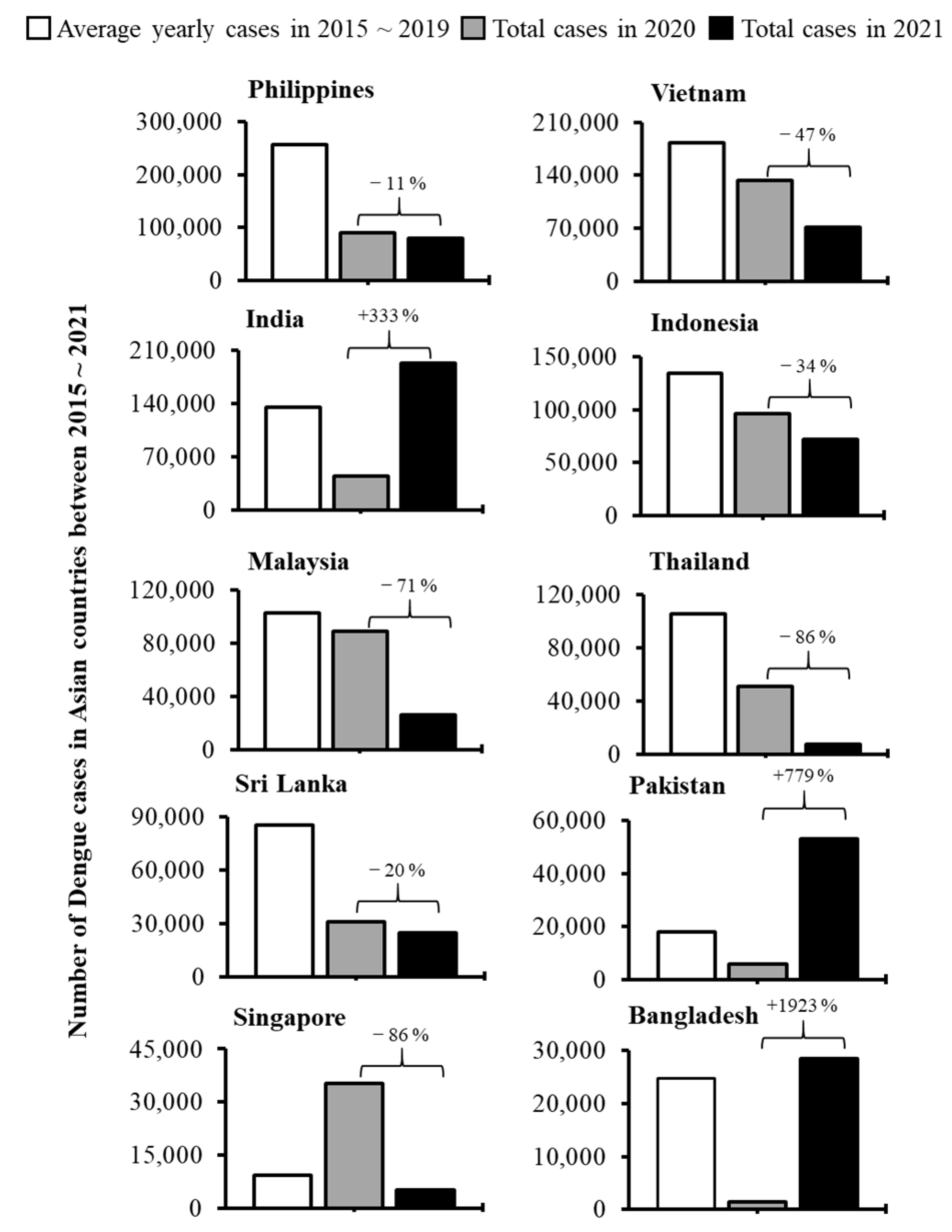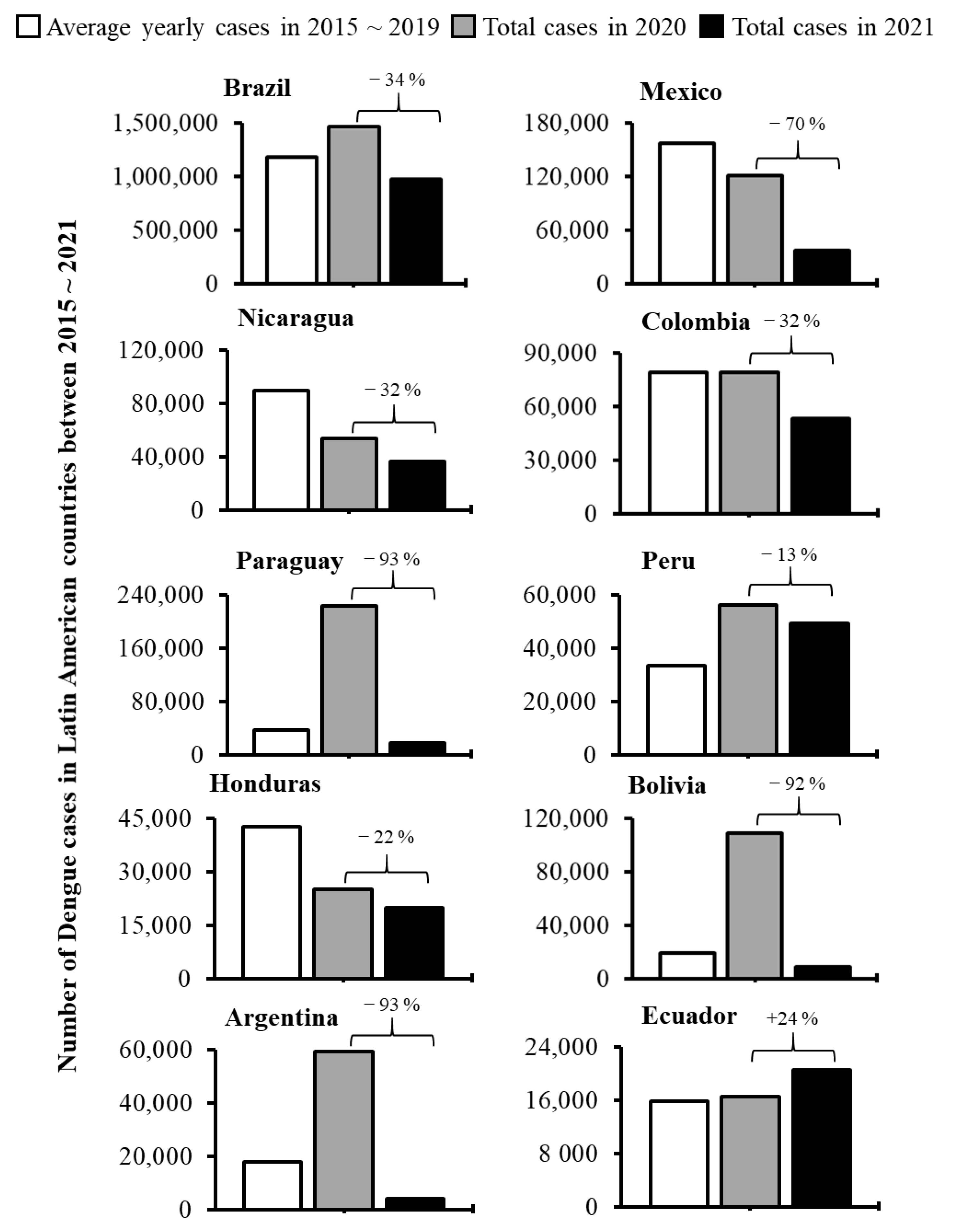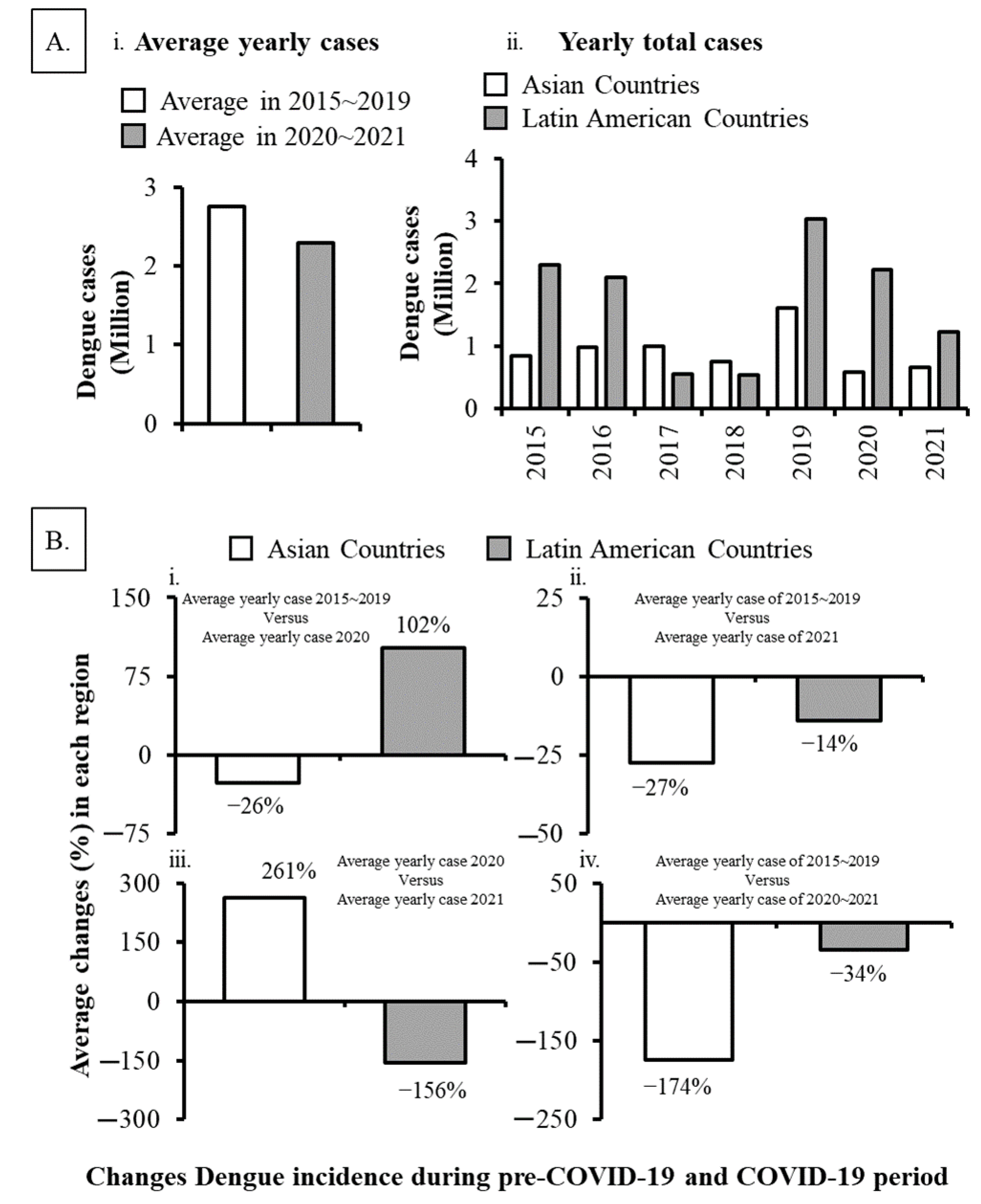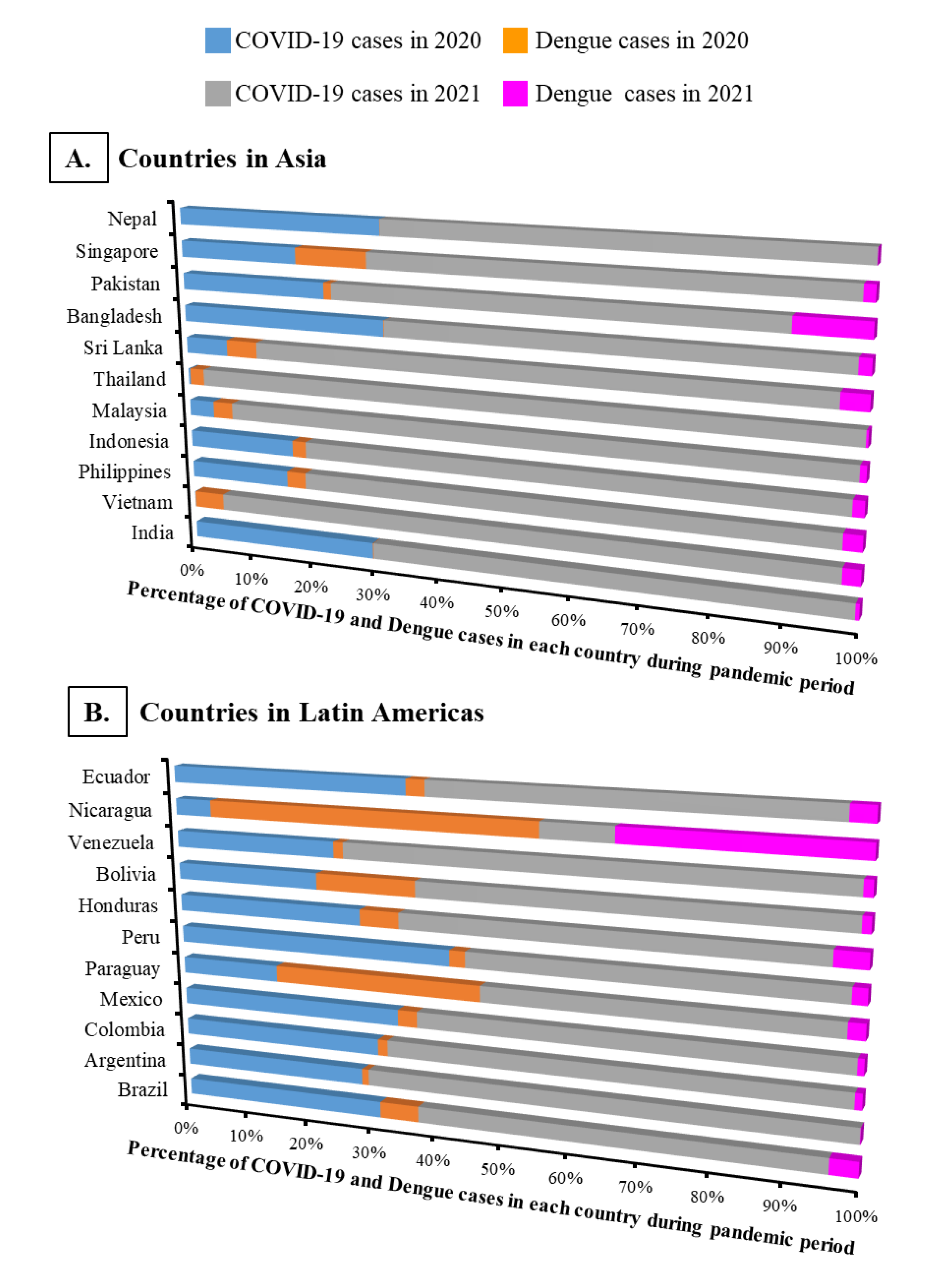Dengue Infections during COVID-19 Period: Reflection of Reality or Elusive Data Due to Effect of Pandemic
Abstract
:1. Introduction
2. Materials and Methods
2.1. Study Design and Geographical Area
2.2. Data Collection and Ethical Aspects
2.3. Data Analysis
3. Results
3.1. Dengue Infections during the Pre-COVID-19 (2015~2019) and COVID-19 (2020~2021) Period
3.2. Comparison of Dengue Infections between Asian and Latin American Countries
3.3. Relationship between Dengue and COVID-19 Cases
3.4. Prediction of Dengue Incidences in 2022
4. Discussion
5. Conclusions
Supplementary Materials
Author Contributions
Funding
Institutional Review Board Statement
Informed Consent Statement
Data Availability Statement
Conflicts of Interest
References
- Bhatt, S.; Gething, P.W.; Brady, O.J.; Messina, J.P.; Farlow, A.W.; Moyes, C.L.; Drake, J.M.; Brownstein, J.S.; Hoen, A.G.; Sankoh, O.; et al. The global distribution and burden of dengue. Nature 2013, 496, 504–507. [Google Scholar] [CrossRef] [PubMed]
- Kularatne, S.A.; Dalugama, C. Dengue infection: Global importance, immunopathology and management. Clin. Med. 2022, 22, 9–13. [Google Scholar] [CrossRef] [PubMed]
- World Health Organization (WHO). Dengue and Severe Dengue (2022). Available online: https://www.who.int/news-room/fact-sheets/detail/dengue-and-severe-dengue#:~:text=Many%20cases%20are%20also%20misdiagnosed,with%20any%20severity%20of%20disease (accessed on 20 June 2022).
- Yang, X.; Quam, M.B.M.; Zhang, T.; Sang, S. Global burden for dengue and the evolving pattern in the past 30 years. J. Travel Med. 2021, 28, taab146. [Google Scholar] [PubMed]
- World Health Organization (WHO). Coronavirus (COVID-19) Dashboard. Available online: https://covid19.who.int/ (accessed on 20 June 2022).
- Cardona-Ospina, J.A.; Arteaga-Livias, K.; Villamil-Gómez, W.E.; Pérez-Díaz, C.E.; Bonilla-Aldana, D.K.; Mondragon-Cardona, Á.; Solarte-Portilla, M.; Martinez, E.; Millan-Oñate, J.; López-Medina, E.; et al. Dengue and COVID-19, overlapping epidemics? An analysis from Colombia. J. Med. Virol. 2021, 93, 522–527. [Google Scholar] [PubMed]
- Harapan, H.; Ryan, M.; Yohan, B.; Abidin, R.S.; Nainu, F.; Rakib, A.; Jahan, I.; Emran, T.B.; Ullah, I.; Panta, K.; et al. COVID-19 and dengue: Double punches for dengue-endemic countries in Asia. Rev. Med. Virol. 2021, 31, e2161. [Google Scholar] [PubMed]
- Tsheten, T.; Clements, A.C.A.; Gray, D.J.; Adhikary, R.K.; Wangdi, K. Clinical features and outcomes of COVID-19 and dengue co-infection: A systematic review. BMC Infect. Dis. 2021, 21, 729. [Google Scholar] [CrossRef] [PubMed]
- Liyanage, P.; Rocklöv, J.; Tissera, H.A. The impact of COVID-19 lockdown on dengue transmission in Sri Lanka; A natural experiment for understanding the influence of human mobility. PLoS Negl. Trop. Dis. 2021, 15, e0009420. [Google Scholar] [CrossRef] [PubMed]
- Lin, S.F.; Lai, C.C.; Chao, C.M.; Tang, H.J. Impact of COVID-19 preventative measures on dengue infections in Taiwan. J. Med. Virol. 2021, 93, 4063–4064. [Google Scholar] [CrossRef]
- Vicente, C.R.; Silva, T.C.C.D.; Pereira, L.D.; Miranda, A.E. Impact of concurrent epidemics of dengue, chikungunya, zika, and COVID-19. Rev. Soc. Bras. Med. Trop. 2021, 54, e08372020. [Google Scholar] [CrossRef] [PubMed]
- Olive, M.M.; Baldet, T.; Devillers, J.; Fite, J.; Paty, M.-C.; Paupy, C.; Quénel, P.; Quillery, E.; Raude, J.; Stahl, J.-P.; et al. The COVID-19 pandemic should not jeopardize dengue control. PLoS Negl Trop Dis. 2020, 14, e0008716. [Google Scholar] [CrossRef]
- Plasencia-Dueñas, R.; Failoc-Rojas, V.E.; Rodriguez-Morales, A.J. Impact of the COVID-19 pandemic on the incidence of dengue fever in Peru. J. Med. Virol. 2022, 94, 393–398. [Google Scholar] [PubMed]
- Reported Cases of Dengue Fever in The Americas. The Pan American Health Organization (PAHO). Available online: https://www3.paho.org/data/index.php/en/mnu-topics/indicadores-dengue-en/dengue-nacional-en/252-dengue-pais-ano-en.html (accessed on 20 June 2022).
- World Health Organization (WHO). Dengue Situation Updates (2020). WHO Regional Office for the Western Pacific. Available online: https://apps.who.int/iris/handle/10665/330698 (accessed on 20 June 2022).
- World Health Organization (WHO). Dengue Situation Updates (2021). WHO Regional Office for the Western Pacific. Available online: https://apps.who.int/iris/handle/10665/341149 (accessed on 20 June 2022).
- Dengue Worldwide Overview. European Centre for Disease Prevention and Control. Available online: https://www.ecdc.europa.eu/en/dengue-monthly (accessed on 20 June 2022).
- Daily Dengue Status Report. Directorate General of Health Services, Bangladesh. Available online: https://old.dghs.gov.bd/index.php/bd/home/5200-daily-dengue-status-report (accessed on 20 June 2022).
- Dengue Situation in India. National Center for Vector Borne Diseases Control (NCVBDC), Ministry of Health & Family Welfare, Government of India. Available online: https://nvbdcp.gov.in/index4.php?lang=1&level=0&linkid=431&lid=3715 (accessed on 20 June 2022).
- Distribution of Notification Dengue Cases. Epidemiology Unit, Ministry of Health, Sri Lanka. Available online: http://www.epid.gov.lk/web/index.php?Itemid=448 (accessed on 20 June 2022).
- Worldometer. Countries in the world by population. Available online: https://www.worldometers.info/world-population/population-by-country/ (accessed on 20 June 2022).
- Chen, Y.; Li, N.; Lourenço, J.; Wang, L.; Cazelles, B.; Dong, L.; Li, B.; Liu, Y.; Jit, M.; Bosse, N.I.; et al. Measuring the effects of COVID-19-related disruption on dengue transmission in southeast Asia and Latin America: A statistical modelling study. Lancet Infect. Dis. 2022, 22, 657–667. [Google Scholar] [PubMed]
- Khan, S.; Akbar, S.M.F.; Nishizono, A. Co-existence of a pandemic (SARS-CoV-2) and an epidemic (Dengue virus) at some focal points in Southeast Asia: Pathogenic importance, preparedness, and strategy of tackling. Lancet Reg Health Southeast Asia 2022, 4, 100046. [Google Scholar] [PubMed]
- Prasertbun, R.; Mori, H.; Mahittikorn, A.; Siri, S.; Naito, T. Pneumonia, influenza, and dengue cases decreased after the COVID-19 pandemic in Thailand. Trop. Med. Health 2022, 50, 27. [Google Scholar] [PubMed]
- Mamun, M.A.; Misti, J.M.; Griffiths, M.D.; Gozal, D. The dengue epidemic in Bangladesh: Risk factors and actionable items. Lancet 2019, 394, 2149–2150. [Google Scholar] [CrossRef]
- Dengue Outbreak. No Mechanism to Collect Data from All Hospitals. NEWAGE Bangladesh. Available online: https://www.newagebd.net/article/147858/no-mechanism-to-collect-data-from-all-hospitals (accessed on 20 June 2022).
- Rahmandad, H.; Lim, T.Y.; Sterman, J. Behavioral dynamics of COVID-19: Estimating underreporting, multiple waves, and adherence fatigue across 92 nations. Syst. Dyn. Rev. 2021, 37, 5–31. [Google Scholar] [PubMed]
- World Health Organization (WHO). Dengue Situation Updates (2022). WHO Regional Office for the Western Pacific. Available online: https://apps.who.int/iris/handle/10665/352792 (accessed on 20 June 2022).
- Lusting, Y.; Keler, S.; Kolodny, R.; Ben-Tal, N.; Atias-Varon, D.; Shlush, E.; Gerlic, M.; Munitz, A.; Doolman, R.; Asraf, K.; et al. Potential antigenic cross-reactivity between SARS-CoV-2 and Dengue viruses. Clin. Infect. Dis. 2020, 73, ciaa1207. [Google Scholar]
- Ayala-Nuñez, N.V.; Jarupathirun, P.; Kaptein, S.J.; Neyts, J.; Smit, J.M. Antibody-dependent enhancement of dengue virus infection is inhibited by SA-17, a doxorubicin derivative. Antivir. Res. 2013, 100, 238–245. [Google Scholar] [CrossRef] [PubMed]
- Liu, Y.; Soh, W.T.; Kishikawa, J.I.; Hirose, M.; Nakayama, E.E.; Li, S.; Sasai, M.; Suzuki, T.; Tada, A.; Arakawa, A.; et al. An infectivity-enhancing site on the SARS-CoV-2 spike protein targeted by antibodies. Cell 2021, 184, 3452–3466.e18. [Google Scholar] [CrossRef]





Publisher’s Note: MDPI stays neutral with regard to jurisdictional claims in published maps and institutional affiliations. |
© 2022 by the authors. Licensee MDPI, Basel, Switzerland. This article is an open access article distributed under the terms and conditions of the Creative Commons Attribution (CC BY) license (https://creativecommons.org/licenses/by/4.0/).
Share and Cite
Khan, S.; Akbar, S.M.F.; Yahiro, T.; Mahtab, M.A.; Kimitsuki, K.; Hashimoto, T.; Nishizono, A. Dengue Infections during COVID-19 Period: Reflection of Reality or Elusive Data Due to Effect of Pandemic. Int. J. Environ. Res. Public Health 2022, 19, 10768. https://doi.org/10.3390/ijerph191710768
Khan S, Akbar SMF, Yahiro T, Mahtab MA, Kimitsuki K, Hashimoto T, Nishizono A. Dengue Infections during COVID-19 Period: Reflection of Reality or Elusive Data Due to Effect of Pandemic. International Journal of Environmental Research and Public Health. 2022; 19(17):10768. https://doi.org/10.3390/ijerph191710768
Chicago/Turabian StyleKhan, Sakirul, Sheikh Mohammad Fazle Akbar, Takaaki Yahiro, Mamun Al Mahtab, Kazunori Kimitsuki, Takehiro Hashimoto, and Akira Nishizono. 2022. "Dengue Infections during COVID-19 Period: Reflection of Reality or Elusive Data Due to Effect of Pandemic" International Journal of Environmental Research and Public Health 19, no. 17: 10768. https://doi.org/10.3390/ijerph191710768
APA StyleKhan, S., Akbar, S. M. F., Yahiro, T., Mahtab, M. A., Kimitsuki, K., Hashimoto, T., & Nishizono, A. (2022). Dengue Infections during COVID-19 Period: Reflection of Reality or Elusive Data Due to Effect of Pandemic. International Journal of Environmental Research and Public Health, 19(17), 10768. https://doi.org/10.3390/ijerph191710768




